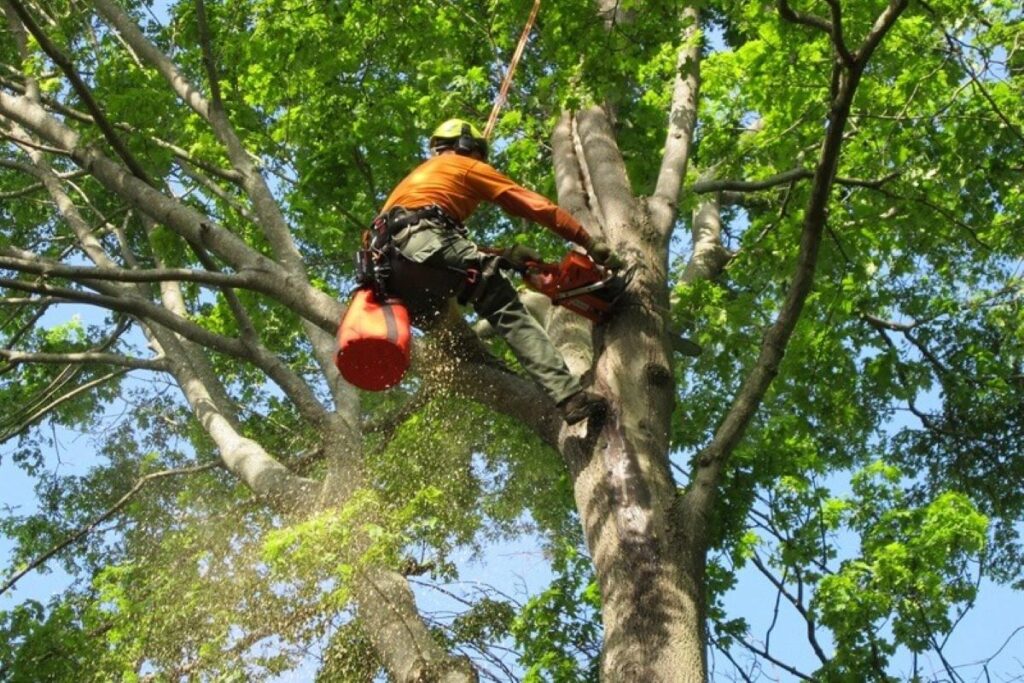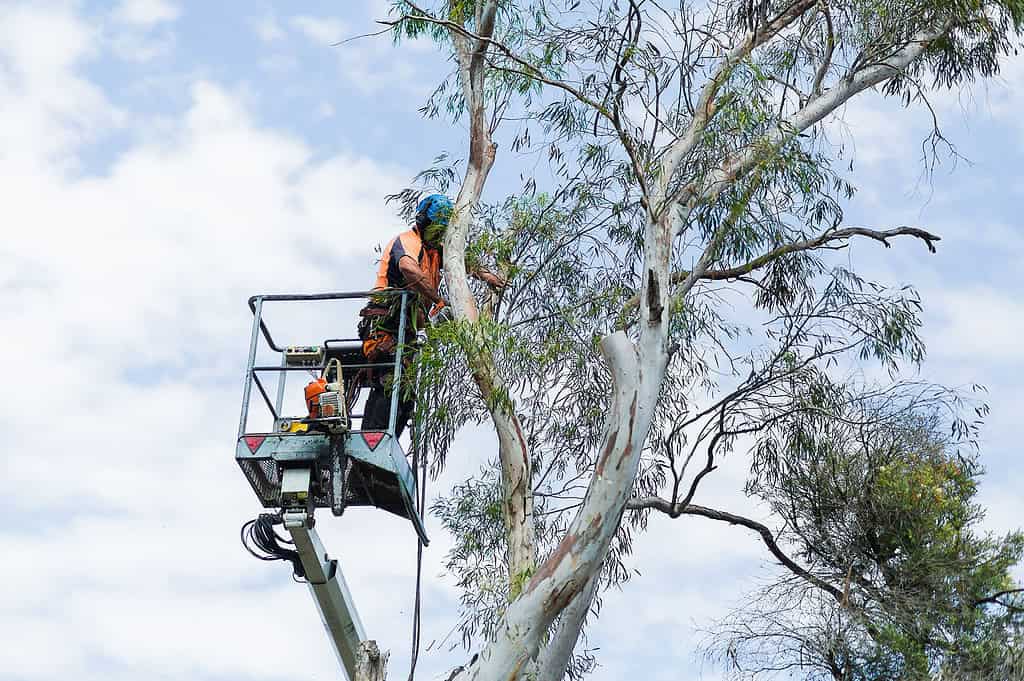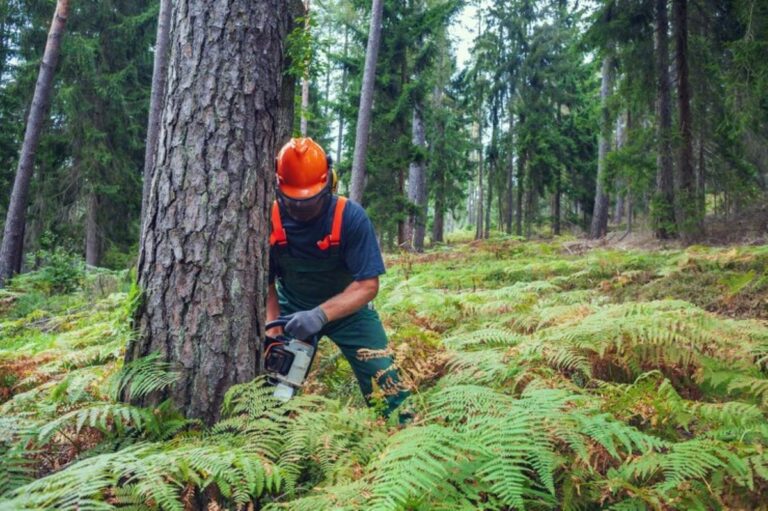Why Is Regular Tree Maintenance Essential in Pymble?
Regular tree maintenance protects Pymble’s mature trees from severe weather events and structural failure. Without consistent professional care, even the healthiest-looking trees develop hidden weaknesses that compromise their ability to withstand strong winds and heavy rainfall.
Risks of Storm Damage for Mature Trees
Mature trees face unique storm damage risks due to their size and age:
- Large canopies catch more wind, creating tremendous force on branches and trunks.
- Older trees often harbour internal decay, deadwood, or structural defects that aren’t visible from ground level.
- Root systems may deteriorate over time, reducing the tree’s anchoring capacity during severe weather.
- Heavy limbs can become unbalanced, making them prone to snapping under storm conditions.
How Professional Arborists Prevent Storm Damage
Professional arborists in Pymble provide critical storm damage prevention through:
- Comprehensive health assessments identifying structural vulnerabilities
- Strategic pruning to reduce wind resistance
- Early detection of disease and decay
- Root system evaluation and management
- Removal of hazardous deadwood before storms strike
An Arborist Pymble specialist understands local weather patterns and native species characteristics. They implement targeted maintenance strategies that strengthen trees against the region’s storm conditions. This proactive approach prevents emergency situations where damaged trees threaten homes, vehicles, and public safety.
Benefits of Regular Tree Maintenance
Regular professional intervention transforms mature trees from potential hazards into resilient landscape features that safely weather Pymble’s storm seasons.
What Expertise Do Arborists Bring to Mature Tree Care in Pymble?
Arborist services Pymble professionals possess specialized knowledge in conducting comprehensive health assessments that identify hidden structural weaknesses, pest infestations, and fungal infections before they compromise tree stability. Their training enables them to spot early warning signs such as cankers, root rot, or internal decay that untrained eyes typically miss.
Professional tree maintenance extends beyond basic trimming. Certified arborists evaluate each tree’s unique characteristics, considering factors like:
- Species-specific growth patterns and vulnerabilities
- Age-related structural changes requiring targeted intervention
- Environmental stressors affecting local Pymble conditions
- Soil composition and drainage impacting root development
This individualized approach ensures mature tree care addresses the precise needs of established specimens rather than applying generic solutions. A 50-year-old eucalyptus requires vastly different care strategies compared to a mature fig or oak of similar age.
Arborists utilize specialized equipment including aerial lifts, rigging systems, and diagnostic tools that enable safe access to tall canopies and accurate assessment of internal tree health. Their adherence to Australian Standards for tree work (AS 4373-2007) guarantees work meets industry safety benchmarks whilst protecting tree vitality.
Advanced techniques such as resistograph testing measure wood density to detect internal decay, whilst sonic tomography maps structural integrity within trunks and major limbs. These technologies provide evidence-based insights that guide precise maintenance decisions rather than guesswork.
How Can Regular Maintenance Reduce Storm Damage Risk to Trees?
Pruning benefits go beyond just looking good—strategic trimming actually makes trees stronger against bad weather. Crown thinning involves removing specific branches to reduce wind resistance, allowing air to flow through the canopy instead of creating a sail-like effect that can knock down entire trees. This targeted method keeps the tree’s natural shape while significantly reducing the force on the trunk and root systems during strong winds.
The Importance of Deadwood Removal
Deadwood removal gets rid of brittle, decayed branches that can become dangerous projectiles in storms. Unlike living wood, dead limbs lack flexibility and easily snap under pressure, posing a threat to property and people below. Certified arborists identify these hazards during regular inspections and remove them before bad weather hits.
Corrective Pruning for Structural Weaknesses
Corrective pruning fixes structural weaknesses that make trees unstable:
- Co-dominant stems that create weak attachment points
- Crossing branches that rub against each other and invite disease
- Overextended limbs that throw off weight distribution
- Narrow branch angles that are likely to split under heavy load
These techniques for preventing storm damage work together to create a balanced, resilient canopy. When trees are properly maintained, they distribute weight evenly, bend instead of breaking in strong winds, and maintain sturdy connections between branches and trunk. Regular pruning also encourages healthy growth patterns, ensuring new wood develops with the right structure from the beginning.
Why Are Health Assessments and Early Disease Detection Important for Storm Resilience?
Regular tree health assessment Pymble services, such as those offered by Sherlock Tree, identify hidden vulnerabilities before storms expose them. Professional arborists detect structural weaknesses like internal decay, root rot, or compromised branch unions that aren’t visible to untrained eyes.
Diseased or infected trees face significantly higher storm damage risk. Fungal infections weaken wood integrity, making branches snap under moderate wind loads. Root diseases compromise anchoring systems, increasing the likelihood of complete tree failure during severe weather events. Early disease detection allows arborists to implement treatment protocols or recommend strategic pruning to remove compromised sections.
Structural defects develop gradually over time:
- Cracks in trunk or major limbs indicate stress points vulnerable to splitting
- Cavities or hollow sections reduce load-bearing capacity
- Weak branch attachments create failure points during high winds
- Leaning trees with exposed roots signal instability issues
Ongoing monitoring through scheduled inspections creates a documented health history for each tree. Arborists track changes in canopy density, bark condition, and growth patterns that signal declining health. This proactive approach catches problems at treatable stages rather than waiting until emergency intervention becomes necessary.
Storm vulnerability increases exponentially when health issues remain unaddressed. A tree weakened by disease or structural defects that might survive calm conditions becomes a serious hazard when wind speeds escalate. Regular professional assessments ensure mature trees maintain the strength required to withstand Pymble’s storm seasons.

How Do Arborists Manage Root Health to Stabilize Mature Trees Against Storms?
Root systems serve as the primary anchor keeping mature trees upright when high winds and heavy rain batter Pymble properties. A healthy, extensive root network distributes the tree’s weight and absorbs ground movement, preventing toppling during severe weather events.
Common root issues that compromise stability include:
- Root rot caused by fungal infections or waterlogged soil
- Compacted soil restricting root growth and oxygen access
- Severed roots from construction or excavation work
- Girdling roots that circle the trunk and weaken the base
- Shallow root systems in trees planted incorrectly
Professional root management Pymble services address these vulnerabilities through targeted interventions. Arborists conduct soil testing to identify drainage problems and nutrient deficiencies that affect root development. They implement aeration techniques to relieve compaction and improve oxygen flow to root zones. When girdling roots threaten tree stability in storms, specialists carefully remove problematic growth without destabilising the entire system.
Mature tree root care extends to installing root barriers that guide growth away from structures whilst maintaining anchoring strength. Arborists apply mulching strategies that retain moisture and regulate soil temperature, encouraging deeper root penetration. Regular root zone inspections detect decay or damage before storms expose these hidden weaknesses, allowing corrective action that preserves the tree’s foundational support system.
What Ongoing Care Plans Do Arborists Offer For Tree Safety and Longevity?
Professional arborists in Pymble design structured ongoing arborist care Pymble programs that maintain tree health through scheduled interventions rather than reactive responses. These tree safety plans typically include quarterly or bi-annual visits where certified professionals assess tree condition, perform necessary pruning, and monitor for emerging issues.
Long-term maintenance schedules are tailored to each property’s specific needs, considering factors like:
- Tree species and maturity levels
- Proximity to structures or power lines
- Historical weather patterns and storm exposure
- Soil conditions and drainage systems
- Aesthetic goals for the landscape
Customized plans address both safety priorities and visual appeal. Arborists schedule crown thinning during optimal seasons, coordinate deadwood removal before storm seasons, and time treatments to maximize tree vigour. This proactive approach identifies potential hazards months before they become critical.
Consistent professional care delivers measurable advantages over sporadic one-off treatments. Trees receiving regular attention develop stronger branch structures, maintain balanced canopies, and show improved resistance to disease. The cumulative effect of scheduled interventions creates resilient specimens that weather storms with minimal damage.
Maintenance contracts also provide cost predictability. Property owners avoid expensive emergency callouts by addressing problems during routine visits. Arborists document tree health over time, creating detailed records that track improvements and inform future care decisions. This systematic approach ensures mature trees remain valuable landscape assets rather than potential liabilities during severe weather events. Read more about Tackling trees after wild weather | SafeWork NSW
When Is Emergency Tree Removal Necessary After A Storm In Pymble?
Emergency tree removal Pymble services become essential when trees pose immediate threats to people or property following severe weather events. Certified arborists assess storm-damaged trees using specific criteria to determine removal necessity.
Identifying Hazardous Trees Requiring Immediate Attention
Trees with split trunks, major limb failures, or severe root plate lifting require urgent removal. Leaning trees that have shifted more than 15 degrees from vertical position indicate compromised stability. Hanging branches caught in canopies—known as “widow makers”—present deadly risks and demand immediate attention.
Hazardous trees post-storm also include those with:
- Exposed root systems where soil has eroded or heaved
- Large cracks running through the main trunk
- Heavy limbs resting on structures or power lines
- Complete uprooting with root balls exposed
Preventing Secondary Damage Through Rapid Response
Storm damage response within 24-48 hours prevents escalating problems. Unstable trees can collapse without warning, causing injuries or crushing vehicles, fences, and buildings. Branches touching electrical infrastructure create electrocution hazards and fire risks.
Local arborist Pymble teams maintain 24/7 emergency availability during storm seasons. These professionals bring specialized rigging equipment, cranes, and safety protocols to remove dangerous trees whilst minimizing collateral damage. Their rapid assessment determines whether partial removal, cabling, or complete extraction provides the safest solution for protecting your property.

Why Choose a Certified Arborist In Pymble For Regular Tree Maintenance?
What makes certified arborists essential for protecting your mature trees from storm damage? A certified arborist Pymble brings specialised training in structural assessments, disease identification, and preventative pruning techniques that directly reduce storm vulnerability. Their qualifications ensure they understand tree biology, proper cutting methods, and safety protocols that untrained operators simply cannot match.
Professional tree care benefits extend beyond immediate storm protection. Certified arborists create customised maintenance schedules that address your trees’ specific needs based on species, age, and environmental conditions. They identify hidden weaknesses in branch unions, detect early signs of root instability, and implement corrective measures before severe weather exposes these vulnerabilities.
Why does certification matter for long-term tree health? Certified professionals carry appropriate insurance, use industry-approved equipment, and follow Australian Standards for tree work. This expertise prevents improper pruning that could weaken trees or create entry points for disease. Regular maintenance by qualified arborists strengthens structural integrity through:
- Strategic crown thinning to reduce wind resistance
- Removal of deadwood and hazardous limbs
- Root zone management for improved stability
- Early intervention for pest and disease issues
Arborist Pymble why regular maintenance prevents storm damage to mature trees becomes clear when you consider the compound benefits of ongoing professional care versus reactive emergency responses.
Don’t wait for the next storm to test your trees’ resilience. Contact a certified arborist in Pymble today to schedule a comprehensive tree assessment and develop a proactive maintenance plan that safeguards your property and preserves your valuable mature trees for years to come.
More to Read : Arborist Turramurra how to preserve heritage listed trees in your backyard
Quick FAQs: Tree Maintenance and Storm Protection in Pymble
It prevents structural failures, reduces storm damage risk, and keeps mature trees healthy and safe.
2. What risks do mature trees face in storms?
Large canopies catch wind, hidden decay or deadwood, weakened roots, and unbalanced limbs can cause breakage or toppling.
3. How do arborists prevent storm damage?
Through health assessments, strategic pruning, deadwood removal, root management, and early disease detection.
4. What techniques strengthen trees against storms?
Crown thinning, corrective pruning, cabling/bracing, and root zone care stabilize trees and improve wind resistance.
5. How do arborists assess tree health?
They detect internal decay, fungal infections, root problems, and structural defects using visual inspections and diagnostic tools.
6. When is emergency tree removal necessary?
After storms, if trees have split trunks, leaning >15°, exposed roots, hanging limbs, or heavy branches on structures/power lines.
7. Why hire a certified arborist in Pymble?
They follow Australian Standards, identify hidden weaknesses, implement preventive care, and reduce storm damage risk safely.
8. How does regular maintenance benefit long-term tree health?
It strengthens branches, balances canopies, prevents disease, ensures structural integrity, and avoids costly emergency interventions.


